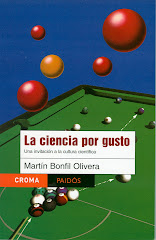By Martín Bonfil Olivera
Published in Milenio Diario, October 7th, 2009
 Nobel prizes are always exciting. This year's Physiology or Medicine prize reveals fascinating basic science about our cells which might have revolutionary applications in health.
Nobel prizes are always exciting. This year's Physiology or Medicine prize reveals fascinating basic science about our cells which might have revolutionary applications in health.
It was awarded, according to the Nobel committee at the Karolinska Institute in
The genetic information of living beings is written in the molecule of deoxyribonucleic acid, DNA, which form tangles called chromosomes within the nuclei on each of our cells.
Each chromosome is formed by a single, very long, DNA molecule. When it has to be copied, before the cell divides in two, the task is performed by an enzyme molecular machine made of protein.
Picture it like this: the famous DNA double helix is like a train railway. To copy it, both rails are separated and the enzyme slides over each one, reading the letters that form it and inserting the corresponding letters on the other side. Like a little train that advances in a rail, constructing the opposing rail. In the end, we have two complete and identical railways.
(http://www.youtube.com/watch?v=hfZ8o9D1tus)
But when the enzyme reaches the end of the rail, it cannot advance any longer, and does not construct the last span of the opposing rail. Each time that a chromosome is copied, their tips (telomeres, from the greek telos, end, and meros, part) would shorten!
Using a very ingenious experiment,
And in 1984 (Christmas day!),
Today we know that telomeres and telomerase play a role in aging and cellular death (when telomeres are shortened) and influence the uncontrolled multiplication of cancerous cells (because their telomerase is very active and their telomeres are not shortened). There are even vaccines in development to try to fight cancer by inactivating the telomerase of tumors.
Basic science, motivated by simple curiosity, offers a new medical promise, although a far one.
(translated by Adrián Robles Benavides) To receive Science for pleasure weekly
in your email, subscribe here!





Wow! That's very interesting. The benefits are obviously many. I will have to check out. Thanks!
ReplyDeleteTerm papers within deadlines.